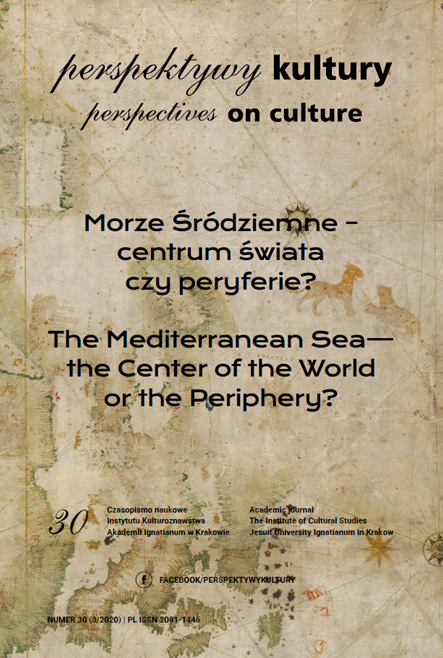Mavi Sürgün by Halikarnas Balıkçısı as a Testament to the Reporter’s Discovery of the Mediterranean Sea for Turkish Literature
Abstract
Mavi Sürgün [Blue Exile] by Halikarnas Balıkçısı is a memoir published in 1961, describing the events of 1920–1947. Its hybrid form contains elements of autobiography and reportage, and the leitmotif is an attempt to introduce the Mediterranean Sea into Turkish literature, and introduce Turkish literature itself into the circle of Mediterranean civilization. The article explains the phenomenon of such a late “discovery” of the Mediterranean Sea for Turkish literature and presents Halikarnas Balıkçısı, the Fisherman of Halicarnassus (his real name is Cevat Şakir Kabaağaçlı), as a person engaged in the literary, touristic, and cultural promotion of the Mediterranean Sea among Turks.
References
Asiltürk, B. (2015). Halikarnas Balıkçısı’nın “Aganta Burina Burinata” Romanında Otobiyografik Yansımalar ve Tanıklıklar. Yeni Türk Edebiyatı Araştırmaları, 14, 21–56.
Atılgan, Z., & Çoban, C. (2019). Cevat Şakir ‘Bodrum’un Mavi Merhabası’. Bodrum: Bodrum Belediyesi.
Balıkçısı, H. (1985). Akdeniz’in Ebedi Gençliği. In Altıncı Kıta Akdeniz (pp. 29–59). Ankara: Bilgi Yayınevi.
Balıkçısı, H. (1986). Mavi Sürgün. Ankara: Bilgi Yayınevi.
Bostan, İ. (1989). Akdeniz. Tarih. In İslam Ansiklopedisi, Vol. 2 (pp. 231–234). İstanbul: Türkiye Diyanet Vakfı.
Duby, G. (1994). Dziedzictwo [Heritage]. In F. Braudel et al., Morze Śródziemne: przestrzeń i historia, ludzie i dziedzictwo [The Mediterranean Sea: Space and history, people, and heritage] (M. Boduszyńska-Borowikowa, B. Kuchta, & A. Szymanowski, Trans., pp. 241–254). Warsaw: Oficyna Wydawnicza Volumen.
Enginün, İ. (2006). Cumhuriyet Dönemi Türk Edebiyatı. İstanbul: Dergah Yayınları.
Gök, İ. (2014). Türklerin Suriye’ye Girişi ve Süleymanşah. Selçuk Üniversitesi Türkiyat Araştırmaları Dergisi, 36, 217–251.
İlgürel, M. (1993). Çaka Bey. In İslam Ansiklopedisi, Vol. 8 (pp. 186–188). İstanbul: Türkiye Diyanet Vakfı.
Inalcik, H. (2006). Imperium osmańskie. Epoka klasyczna 1300–1600 [The Ottoman Empire: Classic era, 1300–1600] (J. Hunia, Trans.). Krakow: Jagiellonian University Press.
Kaplan, Z. (2013). Otobiyografiden Romana: “Mavi Sürgün”de Halikarnas Balıkçısı” [Unpublished paper delivered at the conference “Ulusal Halikar¬nas Balıkçısı Sempozyumu” in 2013 in Muğla]. Retrieved from https:// www.academia.edu/36318780/otob%c4%b0yograf%c4%b0den_romana_ mav%c4%b0_s%c3%9crg%c3%9cn_de_hal%c4%b0karnas_balik%c3%87isi
Köse, F. (2007, October 5). Mavi Sürgün – Halikarnas Balıkçısı. Milliyet. Retrieved from http://blog.milliyet.com.tr/mavi-surgun---halikarnas-balikcisi/ Blog/?BlogNo=67964
Okay, C. (2016). Kabaağaçlı, Cevat Şakir. In İslam Ansiklopedisi. Ek, Vol. 1 (pp. 697–698). İstanbul: Türkiye Diyanet Vakfı.
Opperman, S. (2011). The Fisherman of Halicarnassus’s narratives of the White Sea (the Mediterranean): Translocal subjects, nonlocal connec¬tions. Tamkang Review, 41, 21–39.
Orman, İ.H. (2005). ‘Mehaba’ Halikarnas Balıkçısı. Biyografi. Ankara: Bilgi Yayınevi.
Ortaylı, İ. (2016, August 30). ‘Ordular ilk hedefiniz Akdeniz’dir’ emri neden çok önemli? Hürriyet. Retrieved from https://www.hurriyet.com.tr/gundem/ ordular-ilk-hedefiniz-akdenizdir-emri-neden-cok-onemli-40211800
Płaskowicka-Rymkiewicz, S., Borzęcka, M., & Łabęcka-Koecherowa, M. (1971). Historia literatury tureckiej. Zarys [History of Turkish literature: An outline]. Wrocław: Ossolineum.
Sivri, M., & Kuşca, S. (2013). Halikarnas Balıkçısı’nın Eserlerinde Mitlerin İzleri ve Karşılaştırılmalı Mitolojiye Katkısı. Milli Folklor, 97, 39–52.
Turan, M., & Yinanç, K. (Eds.). (2010). Akdeniz’de Edebiyat, Edebiyatta Akden¬izlilik. Ankara: KIBATEK.
Yalçın, M. (Ed.). (2010). Tanzimat’tan Bugüne Edebiyatçılar Ansiklopedisi. Vol. 1. İstanbul: Yapı Kredi Yayınları.
Yılmaz, A., & Yetgin, D. (2018). Mavı Yolculuktan Yat Turizmine Geçiş. In N. Kozak (Ed.), Dünden Bugüne Türkiye’de Turizm (pp. 847–858). İstanbul: Detay Yayıncılık.
Williams, R. (2013). The Fisherman of Halicarnassus: The man who made Bodrum famous. Bristol: Bristol Book Publishing.
Copyright (c) 2020 Jesuit University Ignatianum in Krakow

This work is licensed under a Creative Commons Attribution-NoDerivatives 4.0 International License.
Autor, zgłaszając swój artykuł, wyraża zgodę na korzystanie przez Wydawnictwo Uniwersystet Ignatianum z utworu na następujących polach eksploatacji:
- utrwalania utworu w formie papierowej, a także na nośniku cyfrowym lub magnetycznym;
- zwielokrotnienia utworu dowolną techniką, bez ograniczenia ilości wydań i liczby egzemplarzy;
- rozpowszechniania utworu i jego zwielokrotnionych egzemplarzy na jakimkolwiek nośniku, w tym wprowadzenia do obrotu, sprzedaży, użyczenia, najmu;
- wprowadzenia utworu do pamięci komputera;
- rozpowszechniania utworu w sieciach informatycznych, w tym w sieci Internet;
- publicznego wykonania, wystawienia, wyświetlenia, odtworzenia oraz nadawania i reemitowania, a także publicznego udostępniania utworu w taki sposób, aby każdy mógł mieć do niego dostęp w miejscu i czasie przez siebie wybranym.
Wydawca zobowiązuje się szanować osobiste prawa autorskie do utworu.





